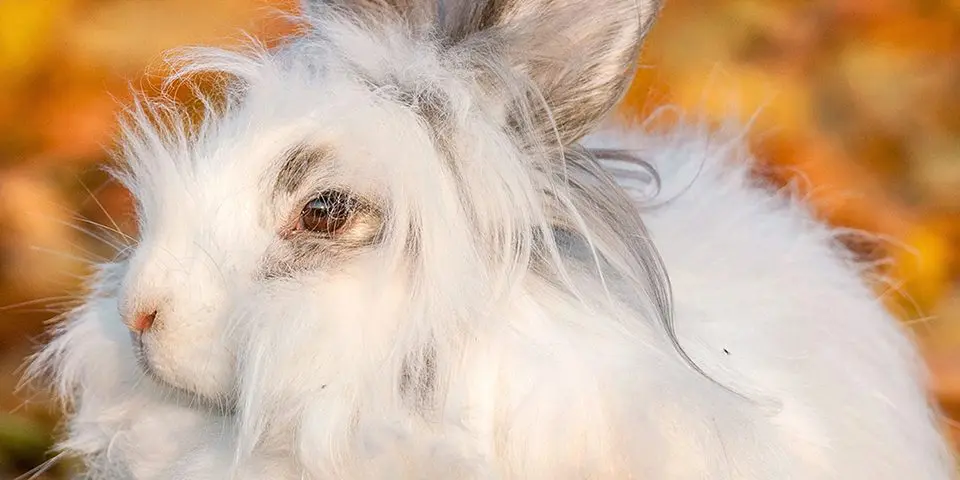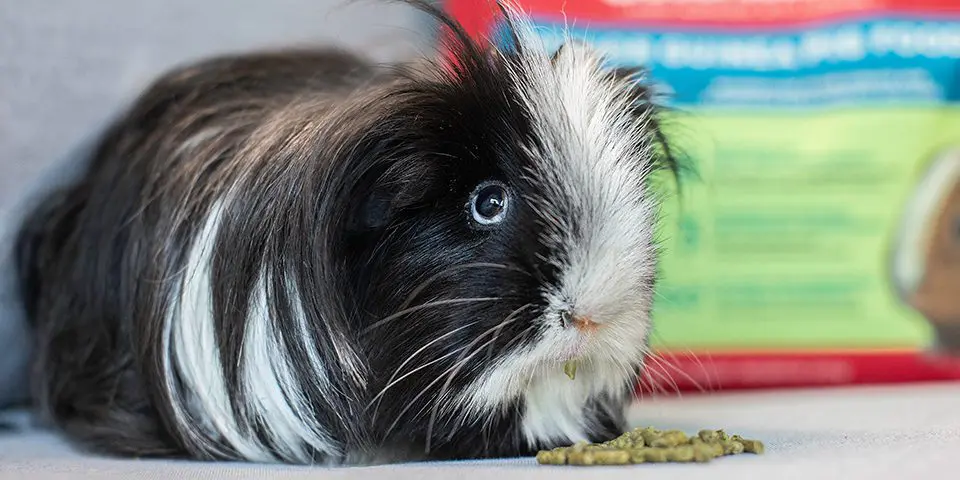Authors: Cayla Iske, Ph.D, Dianne Cook, LVT, and Kellie Hayden
Updated: June 15, 2024
What’s the first thing that springs to mind when you see the word “hairball?” If you’re like most people, you’ll conjure up the wads of hairy yuck that cats tend to hack up. In that case, it might come as a surprise to learn that many exotic companion mammals – including rabbits and guinea pigs – are also susceptible to hairballs.
If you’re a pet parent to a small exotic such as a rabbit, guinea pig, or chinchilla, you’ll want to know the signs and symptoms of hairballs. At the same time, you’ll want to know how to prevent hairballs in rabbits and guinea pigs from happening, along with how to treat them.
In this article, we’ll cover the basics of hairballs in rabbits, guinea pigs, and other small mammals, including:
- What Types of Small Mammals Get Hairballs?
- What Causes Hairballs in Rabbits and Guinea Pigs?
- Hairball Signs and Symptoms
- Hairball Prevention Tips
- Hairball Treatment Options
What Type of Small Mammals Get Hairballs?
Technically, any animal who ingests hair can form a hairball, but they tend to be more common in certain species. Below, we’ll explain which types of small mammals are at particular risk of hairballs.
Hairballs in Rabbits
Rabbits face an increased risk of hairballs compared to other small mammals due to their naturally dense hair coats. Longhaired rabbit breeds like angoras, lionheads, and Jersey woolies have an even greater risk due to the length of their hair.
Hairballs in Guinea Pigs
Guinea pig parents may also be wondering, “can guinea pigs get hairballs?” While guinea pigs with longer hair will face a higher risk of hairballs, guinea pigs with shorter hair tend to be at lower risk. Guinea pig breeds like silkies, Peruvians, and texels have their long, luxurious locks to thank for an elevated chance of hairballs compared to their shorter-haired piggy kin.
Hairballs in Other Small Mammals
Hairballs in rabbits, guinea pigs, and other small mammals are caused by swallowing hair. While the ingestion of hair is normal for small mammals, this hair can build up over time, which leads to hairballs.
Factors that increase the risk of hairballs in rabbits and guinea pigs, as well as other species, include:
- Longer or thicker hair
- Shedding
- Hair chewing
- Stress
- Pain or illness
- Improper diet
- Dental disease
Because rabbits and rodents are instinctively fastidious creatures, they routinely swallow some of their hair whenever they groom themselves. As a result, it is completely normal for them to have hair in their stomach and along their gastrointestinal tract. Under normal circumstances, this hair passes in their stool without incident.
True hairballs (also called trichobezoars or “wool block”), on the other hand, are tightly compacted wads of ingested hair or hair-like fibers that accumulate in the stomach. Though true hairballs are not overly common in rabbits, guinea pigs, and other small pets, they do sometimes happen.
Rabbits and guinea pigs with exceptionally long or thick coats are more likely to have issues. Hairball risk is also higher for rabbits and guinea pigs who are shedding or prone to excessive grooming or barbering (hair chewing) of themselves or their cage mate. While pet parents can work with their exotics veterinarian to help curb these behaviors, it can be very difficult to get your pet to stop eating hair entirely.
Poor gastrointestinal motility also increases the risk of hairballs. As a result, rabbits and guinea pigs with either acute or chronic digestive issues are at higher risk of hairball formation.

Hairball Symptoms in Rabbits and Guinea Pigs
Unlike cats, our rabbit and rodent friends are unable to vomit. That unfortunately means if a true hairball forms, it only has one direction to go, and the only way out is quite narrow. This can result in the hairball becoming lodged, effectively bringing your pet’s GI tract to a grinding halt. While this is problematic in all species, it is particularly scary in our small herbivores, and can easily result in (or result from) a serious and even life-threatening condition called gastrointestinal stasis.
Because small mammals are prey species, they are intrinsically designed to mask signs of pain or illness. Whether you’re keeping a close, watchful eye on your rabbit for hairball symptoms or have never considered that hairballs can form in small mammals, this means the initial signs of a hairball can be quite subtle and pass under the radar of even the most vigilant pet parent. If your pet exhibits any of the following signs or symptoms, contact a trusted veterinarian immediately.
Pet parents should keep an eye out for the following symptoms of hairballs in rabbits and guinea pigs:
- Decreased or absent appetite
- Decreased fluid intake
- Decreased fecal output
- Small and/or oddly shaped fecal pellets – “string of pearls” feces (small pellets of feces strung together with strands of hair) is quite common
- Inconsistent stool consistency – alternating between dry and firm and soft or watery
- Lethargy
- Abdominal distention – stomach looks enlarged
- Abnormal vocalization – teeth grinding, thumping, and whimpering can indicate pain
- Abnormal posture – sitting or lying rigidly in one position or “abdominal pressing” (lying stretched out with their abdomen pressed against the ground) can also be a sign of discomfort
4 Easy Ways to Prevent Hairballs in Rabbits and Guinea Pigs
While some animals are prone to hairballs, there are measures you can take to reduce your pet’s chances of developing issues. Preventing hairballs means making thoughtful choices and developing healthy habits when it comes to your pet’s nutrition, hydration, supplements, and grooming.
Below are four important hairball prevention tips for rabbit and guinea pig pet parents:
1. Provide Appropriate, High Fiber Nutrition
As mentioned above, an improper diet can contribute to any ingested hair clumping and getting stuck along the digestive tract. This is yet another reason adequate fiber in the diet of a small mammal is crucial. Sufficient volumes of insoluble fiber help maintain peristalsis and keep the digestive system moving, reducing the likelihood that hair will congregate throughout. Fiber is one of the best items in your toolbox for rabbit hairball prevention especially. The best method of getting fiber into your small herbivore’s diet is to provide a large amount of Western Timothy Hay in their enclosure and to ensure that their hay is constantly replenished.
2. Ensure Adequate Hydration
In addition to fiber, proper hydration also aids in maintaining peristalsis. Dehydration can be avoided by offering fresh water in multiple formats (crock and bottle) as well as feeding a proper amount of fresh greens and veggies. Fresh produce adds great nutritional variety to the diet and is also high in moisture to help hydrate your pet.
3. Offer Digestive Supplements as Appropriate
If your little one is predisposed to hairballs or has a history of hairball issues, adding a digestive supplement to the diet may be a great option as well. Oxbow’s Natural Science Digestive Support or Papaya support, or even both, can help boost digestive health and movement. Papaya Support specifically contains active, plant-based enzymes which help break down proteins in the digestive tract, which could include accumulations of hair. As always, consult with your animal’s veterinarian before adding any supplement to the diet.
4. Practice Consistent Grooming
In addition to a fiber-rich diet and ample water intake, a consistent grooming routine can also minimize the chances of hairball formation by ensuring your little one isn’t ingesting excessive quantities of hair. Daily brushing is especially important if your pet has long hair or is shedding. Though it can take a bit of time to get your furry friend accustomed to a regular grooming habit, many small mammals learn to love this special bonding time with their favorite humans. This frequent one-on-one time will also allow you to keep a close eye on your pet’s overall coat health and body condition.

Hairball Treatment for Rabbits and Guinea Pigs
Should your little one form a true hairball, it can come as a comfort to know that hairballs in rabbits, guinea pigs, and other small mammals are generally treatable.
Because true hairballs are often the result of gastrointestinal stasis and other serious digestive diseases, however, they are considered a major health concern. It is imperative to have the guidance and expertise of an exotics-savvy veterinarian throughout the treatment process.
Depending on the size and location of the true hairball, coupled with your pet’s overall condition, your veterinarian may recommend treatment including some (or all) of the following options.
Fluid Therapy
Rabbit hairball treatment, as well as hairball treatment in other species, often relies first on fluid therapy. Though fluids can be given orally or subcutaneously, often intravenous fluids and a short hospital stay are the best options to rehydrate your kiddo’s system and get the hairball moving through.
Assist Feeding
If your pet isn’t eating, their digestive tract isn’t moving. A sign that their GI tract may have already stopped includes your pet refusing food and water when offered. Part of treating hairballs includes ensuring your pet’s digestive system gets back on track. Feeding a recovery diet like Critical Care can help stimulate peristalsis (movement of the intestines) to combat GI stasis, and provide your pet with the macro- and micro-nutrients they need until they are able to resume self-feeding and pass consistent bowel movements.
Medication
A variety of medications may be prescribed based on your little one’s unique case and overall condition. Analgesics (pain medication), antibiotics, prokinetics (medications that promote gastrointestinal movement), and anti-gas meds are used most commonly. If you are introducing a medication into your pet’s schedule, monitor what and how much they eat and drink. Every animal is unique and should be monitored for changes when taking medication in case their appetite becomes suppressed as a side effect of prescribed medicine.
Surgery
Occasionally a true hairball can cause a complete intestinal obstruction and will have to be removed surgically. Because little ones in this state are generally quite ill (and therefore not the best anesthetic candidates), surgery is generally a last resort.
Conclusion
As pet parents, we want what is best for our little ones, even when situations might get a little hairy. We hope this guide has successfully prepared you to prevent—and if necessary, treat—hairball issues in your exotic pet.
For more helpful pet parent tips, check out Oxbow’s Rabbit Care Guide and Guinea Pig Care Guide.
